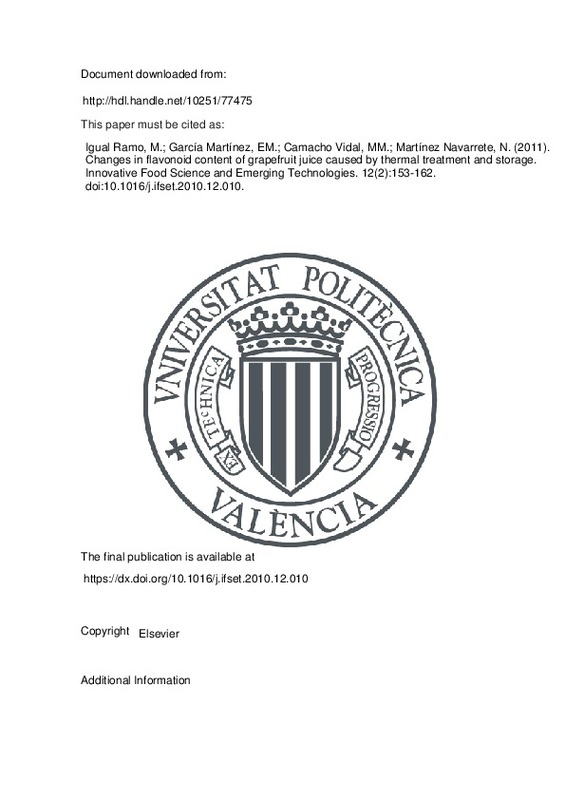JavaScript is disabled for your browser. Some features of this site may not work without it.
Buscar en RiuNet
Listar
Mi cuenta
Estadísticas
Ayuda RiuNet
Admin. UPV
Changes in flavonoid content of grapefruit juice caused by thermal treatment and storage
Mostrar el registro sencillo del ítem
Ficheros en el ítem
| dc.contributor.author | Igual Ramo, Marta
|
es_ES |
| dc.contributor.author | García Martínez, Eva María
|
es_ES |
| dc.contributor.author | Camacho Vidal, Mª Mar
|
es_ES |
| dc.contributor.author | Martínez Navarrete, Nuria
|
es_ES |
| dc.date.accessioned | 2017-01-31T11:32:52Z | |
| dc.date.available | 2017-01-31T11:32:52Z | |
| dc.date.issued | 2011-04 | |
| dc.identifier.issn | 1466-8564 | |
| dc.identifier.uri | http://hdl.handle.net/10251/77475 | |
| dc.description.abstract | The effect of conventional and microwave pasteurization on the main flavonoids present in grapefruit juice and their stability throughout 2 months of refrigerated and frozen storage was evaluated. Individual flavonoids were analyzed by HPLC. The results showed that naringin, narirutin, quercetin and naringenin were the most abundant flavonoids in grapefruit juice. In general, although every pasteurization treatment caused a significant reduction in the content of all the studied flavonoids, the treated samples were more stable during storage. While fresh squeezed juice (FS) and conventional pasteurized juice (CP) were better preserved under refrigeration conditions, microwave pasteurized juice (MP) conserved better when frozen stored. In fact, after 2 months, frozen MP samples showed the greatest flavonoid retention. From this point of view, microwave treatment can be considered a good alternative to conventional pasteurization. Industrial relevance: Flavonoids are polyphenolic compounds present in fruits and vegetables relevant not only in terms of quality, as they influence the visual appearance and taste, but also from a therapeutical point of view, as they appear to be associated with the prevention of degenerative diseases. The consumption of grapefruit juice is fairly widespread among the population. Traditionally, juices have been pasteurized by heat treatment to prolong their shelf life. However, this process may cause irreversible losses of nutritional quality and antioxidant activity and, in consequence, may affect their health-related properties. In this sense, the use of microwaves can be considered an alternative to conventional thermal pasteurization. Microwave energy was applied as alternative to conventional heating for grapefruit juice pasteurization. The results obtained in this study showed that when the effect of pasteurization process and storage is considered together, the use of microwave energy led to a greater retention of all the analyzed flavonoids, thereby representing a good alternative to conventional pasteurization. In this case, frozen storage of processed product would be recommended to better preserve these compounds. © 2011 Elsevier Ltd. All rights reserved. | es_ES |
| dc.description.sponsorship | The authors wish to thank the Ministerio de Educacion y Ciencia and FEDER for their financial support throughout the Project AGL 2005-05994. | en_EN |
| dc.language | Inglés | es_ES |
| dc.publisher | Elsevier | es_ES |
| dc.relation.ispartof | Innovative Food Science and Emerging Technologies | es_ES |
| dc.rights | Reconocimiento - No comercial - Sin obra derivada (by-nc-nd) | es_ES |
| dc.subject | Flavonoids | es_ES |
| dc.subject | Grapefruit | es_ES |
| dc.subject | High performance liquid chromatography | es_ES |
| dc.subject | Juice | es_ES |
| dc.subject | Microwaves | es_ES |
| dc.subject | Pasteurization | es_ES |
| dc.subject | Refrigerated and frozen storage | es_ES |
| dc.subject | Antioxidant activities | es_ES |
| dc.subject | Conventional heating | es_ES |
| dc.subject | Degenerative disease | es_ES |
| dc.subject | Flavonoid content | es_ES |
| dc.subject | Frozen storage | es_ES |
| dc.subject | Grapefruit juice | es_ES |
| dc.subject | Irreversible loss | es_ES |
| dc.subject | Microwave energies | es_ES |
| dc.subject | Microwave treatment | es_ES |
| dc.subject | Naringin | es_ES |
| dc.subject | Nutritional qualities | es_ES |
| dc.subject | Polyphenolic compound | es_ES |
| dc.subject | Shelf life | es_ES |
| dc.subject | Thermal treatment | es_ES |
| dc.subject | Visual appearance | es_ES |
| dc.subject | Chromatography | es_ES |
| dc.subject | Fatty acids | es_ES |
| dc.subject | Fruits | es_ES |
| dc.subject | Heat treatment | es_ES |
| dc.subject | Liquids | es_ES |
| dc.subject | Phenols | es_ES |
| dc.subject | Radio waves | es_ES |
| dc.subject | Visualization | es_ES |
| dc.subject | Citrus x paradisi | es_ES |
| dc.subject.classification | TECNOLOGIA DE ALIMENTOS | es_ES |
| dc.title | Changes in flavonoid content of grapefruit juice caused by thermal treatment and storage | es_ES |
| dc.type | Artículo | es_ES |
| dc.identifier.doi | 10.1016/j.ifset.2010.12.010 | |
| dc.relation.projectID | info:eu-repo/grantAgreement/MEC//AGL2005-05994/ES/AGL2005-05994/ | es_ES |
| dc.rights.accessRights | Abierto | es_ES |
| dc.contributor.affiliation | Universitat Politècnica de València. Departamento de Tecnología de Alimentos - Departament de Tecnologia d'Aliments | es_ES |
| dc.contributor.affiliation | Universitat Politècnica de València. Escuela Técnica Superior de Ingeniería Agronómica y del Medio Natural - Escola Tècnica Superior d'Enginyeria Agronòmica i del Medi Natural | es_ES |
| dc.description.bibliographicCitation | Igual Ramo, M.; García Martínez, EM.; Camacho Vidal, MM.; Martínez Navarrete, N. (2011). Changes in flavonoid content of grapefruit juice caused by thermal treatment and storage. Innovative Food Science and Emerging Technologies. 12(2):153-162. https://doi.org/10.1016/j.ifset.2010.12.010 | es_ES |
| dc.description.accrualMethod | S | es_ES |
| dc.relation.publisherversion | https://dx.doi.org/10.1016/j.ifset.2010.12.010 | es_ES |
| dc.description.upvformatpinicio | 153 | es_ES |
| dc.description.upvformatpfin | 162 | es_ES |
| dc.type.version | info:eu-repo/semantics/publishedVersion | es_ES |
| dc.description.volume | 12 | es_ES |
| dc.description.issue | 2 | es_ES |
| dc.relation.senia | 209016 | es_ES |
| dc.contributor.funder | Ministerio de Educación y Ciencia | es_ES |







![[Cerrado]](/themes/UPV/images/candado.png)

